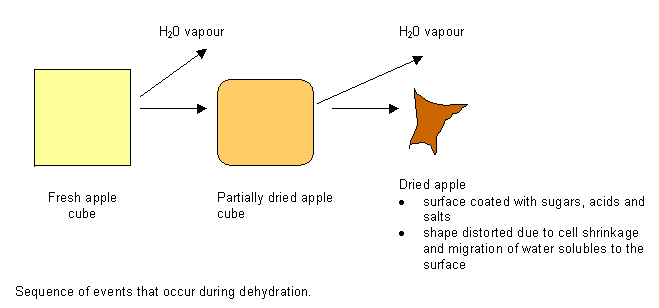Course:FNH200/Lessons/Lesson 08/Page 08.2
< Course:FNH200 | Lessons | Lesson 08
8.2 Changes in Food during Dehydration
Similar to the other preservation methods we have reviewed, dehydration will cause changes in the food that need to be controlled in order to maintain the highest quality possible. Some of these changes are:
- Cell/tissue Shrinkage. As water is removed from food pieces during dehydration, the cells within the tissue shrink and lose their elasticity. If you have purchased dehydrated vegetables such as carrots, onion slices, or dehydrated fruits such as apple cubes or slices you may have observed the shrinkage that has occurred. Part of the reason for shrinkage of foods that have been dehydrated is that the water migrates from the interior of the food to the surface where it finally evaporates and is carried away by the dehydrating medium. As the water migrates to the surface of the food it carries with it the water soluble substances dissolved in it. The loss of these substances from the interior of the food pieces contributes to the shrinkage observed in dehydrated foods and also contributes to the poor rehydration properties of such foods. Loss of the water soluble components from the interior portions of the food pieces decreases the driving force for attraction of water into the food pieces during rehydration.
Sequence of events that occur during dehydration.
(A) Fresh apple cube
(B) Partially dried apple cube
(C) Dried apple surface coated with sugars, acids and salts shape distorted due to cell shrinkage and migration of water solubles to the surface
- Case hardening. Case hardening occurs when rapid drying causes compounds such as sugars to form a hard, fairly impermeable case around the food piece. This phenomenon can cause the rate of dehydration to decrease. Case hardening can occur in high-sugar products such as tropical fruit and many temperate fruit products. Dehydration procedures are designed to minimize the development of case hardening as much possible.
- Chemical changes. A number of chemical changes occur in foods during dehydration in systems employing warm air as the drying agent. The Maillard browning reactions (Lesson 2) cause the development of brown colours and the formation of flavours not originally associated with the fresh product. The Maillard reactions proceed most rapidly when the water content of the food is in the range of 20% down to 15% because the reactants are in very close proximity, which increases the probability of reactions occurring. Thus, drying systems are designed to remove water through the 20-15% range of moisture content as rapidly as possible. This will minimize the negative effects the Maillard reaction has on the flavour of dehydrated food products. The flavour of rehydrated skim milk powder is due largely to the products of the Maillard reaction during dehydration of the milk. Prior to dehydration of egg whites, they are treated with an enzyme, glucose oxidase, which "de-sugars" the egg whites and minimizes the colour and flavour changes that could be caused by the Maillard reactions involving glucose. Poor rehydration can occur because of the loss of the ability of some hydrophilic food constituents to absorb water. Heat denaturation of proteins, starches and gums can decrease the water-holding capacity of dehydrated foods. The salts and sugars concentrated on the outside of the food pieces will dissolve in the water added to the food to rehydrate it. Since those water soluble components are not inside the food pieces, there is less attraction for water to enter the food product. As result, rehydration is less complete. You may have noticed that dehydrated fruit pieces are much sweeter than the fresh fruit. The reason for this phenomenon is that the sugars are concentrated on the outside of the fruit. Loss of volatile substances that contribute to the flavour of foods occurs during dehydration. Generally the higher the drying temperature, the larger the loss of volatiles, with the result that the dehydrated food is less flavourful than the initial product.
Dehydrated foods may show varying extents of shrinkage or chemical changes, depending on the method and conditions used to dry the food.
